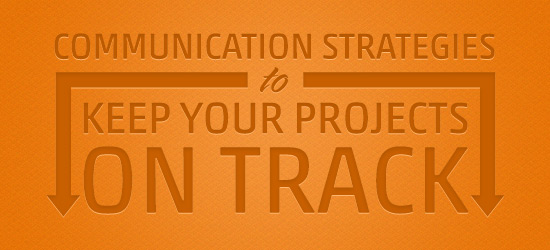Not sure what accessibility changes will have the most benefit to your existing software? Are you in the build process and need to make sure accessibility has been appropriately considered? Use this checklist as a starting point.
Communication Strategies to Keep Your Projects on Track
BusinessThis is a guest post by Ashley Janssen of AgileStyle. Thanks Ashley!
The success or failure of a project, no matter what industry you are in, often hinges on how effective the communication is between all involved parties. When speaking specifically about web design/development, this doesn’t just refer to communication between you and your client, but also between you and your team.
As freelancers, and even small firms, you are often not only the designer or developer but also the project manager. The following are a few things to keep in mind to keep the communication channels as clear as possible and help keep your projects moving smoothly.

1. You need to plan
There is nothing worse then being in the middle of a project and realizing that you didn’t plan well enough for your clients needs, or they didn’t communicate them to you clearly enough. You end up with wicked scope creep, timelines getting pushed back, and both you and your client getting grumpy.
The best way to prevent this is tons of upfront planning. Brainstorm all of the potential features and content, identify the purpose and goals for each, and sketch out an initial concept on a piece of paper.
Some clients are very specific about what they want and have a very clear vision…but most are not. It is a dangerous game to start a project that you only have a vague sense of, so depending on the size and scope of the project, consider having an additional planning session and getting client approval of the results. These sessions can be part of your quoting process or integrated into your quotes as a paid service.
2. Don’t over plan
This might seem counter intuitive to the point above but the idea is to ensure your plan covers as much high level ideas as possible, but not to get caught up in very specific details. Don’t fall into the trap where excessive planning leaves you with no flexibility to change and adjust as the project moves forward. It is impossible to prevent change: something will come up, the client will change their mind, a new feature will be added or removed. If you get to caught up in the initial plan, it can be restrictive and actually cause more harm then good.
3. Have a detailed contract
So, you have had an awesome planning session with your client, you feel comfortable with the project, and have a good understanding of what your client wants. Write it down, price it out, and get them to sign off on it.
If things turn sideways you need to have a contract outlining exactly what you agreed to do (and more more importantly, what you have not agreed to do) so that you are protected. This is also a good way to control scope creep as you can reference the contract when your client requests something that is not part of your initial agreement. What is the price to add a feature during the design phase? After the production phase? When will new features be delivered? When do design revisions start costing more? Your client will have these questions, and if you educate them in advance, you can have a major change to the project without damaging your relationship.
4. Build wireframes
Lots of designers/developers use them, lots don’t. I think they are vital and save a lot of time/aggravation in the long run. The benefit is that you communicate structure to the client, giving them a much better idea of what they will be getting before a design is completed. A wireframe can be changed quickly and at a significantly lower cost than a full design, and it will need to change!
5. Meet throughout the project
Now that you are working away on the project, schedule a weekly or bi-weekly meeting with your client to keep them up to date on progress. This keeps the communications lines flowing so you don’t get too far on something only to find out your client doesn’t like it. It also helps keep you goal oriented and on schedule.
This may seem excessive for smaller projects, but your client will feel more involved in the process, which means they are more likely be more satisfied with the end result.
Make sure you account for meeting time in your project quote!
6. Set communication expectations with your team
Communication with your team is just as important as communication with your client. Finding out that your developer went on a 5 day camping trip in the middle of a project without telling you makes for an unhappy relationship, especially if you have deadline looming. The client isn’t going to care that your developer is suddenly incommunicado. All they know is that you missed a deadline, and they don’t like it.
This might mean that you require your contractor to check in every two days with a status update. It might mean that you have a weekly Skype video chat. It might be a 15 minute daily morning project review. You could share Google calendars, or chat through the day on instant messenger, IRC, or Campfire. What ever it is, establish your communication expectations early and work at it.
Summary
No project ever runs perfectly smoothly; there will always be something that throws a wrench in it. However, if you consider some of the above methods and integrate them into your project process, you will likely help prevent some of the major issues that can come up in a project due to miscommunication.
What strategies do you use to ensure a smooth-running web design/development project?
